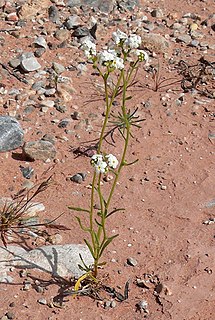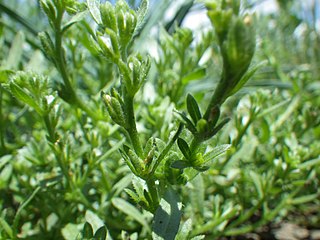| Plagiobothrys canescens | |
|---|---|
 | |
| Scientific classification | |
| Kingdom: | Plantae |
| Clade: | Angiosperms |
| Clade: | Eudicots |
| Clade: | Asterids |
| Order: | Boraginales |
| Family: | Boraginaceae |
| Genus: | Plagiobothrys |
| Species: | P. canescens |
| Binomial name | |
| Plagiobothrys canescens | |
Plagiobothrys canescens is a species of flowering plant in the borage family known by the common name valley popcornflower. [1] It is endemic to California, where it is a common wildflower in valley, foothill, desert, coastline, and canyon habitat in the central and southern regions of the state.

The flowering plants, also known as angiosperms, Angiospermae or Magnoliophyta, are the most diverse group of land plants, with 64 orders, 416 families, approximately 13,000 known genera and 300,000 known species. Like gymnosperms, angiosperms are seed-producing plants. However, they are distinguished from gymnosperms by characteristics including flowers, endosperm within the seeds, and the production of fruits that contain the seeds. Etymologically, angiosperm means a plant that produces seeds within an enclosure; in other words, a fruiting plant. The term comes from the Greek words angeion and sperma ("seed").

Boraginaceae, the borage- or forget-me-notfamily, includes a variety of shrubs, trees, and herbs, totaling about 2,000 species in 146 genera found worldwide.

Endemism is the ecological state of a species being unique to a defined geographic location, such as an island, nation, country or other defined zone, or habitat type; organisms that are indigenous to a place are not endemic to it if they are also found elsewhere. The extreme opposite of endemism is cosmopolitan distribution. An alternative term for a species that is endemic is precinctive, which applies to species that are restricted to a defined geographical area.
Plagiobothrys canescens is an annual herb with a spreading or erect stem 10 to 60 centimeters in length. The leaves are located in a basal rosette about the base of the stem, with smaller ones located along the stem's length. The plant is coated in long, rough hairs and sometimes bristles. It is purple-edged and -veined and leaks purple juice when crushed. The inflorescence is a series of tiny flowers and hairy bracts. Each five-lobed white corolla measures 2 to 3 millimeters wide. The fruit is a rounded, arched nutlet no more than 2 millimeters long textured with cross-ribs.

An inflorescence is a group or cluster of flowers arranged on a stem that is composed of a main branch or a complicated arrangement of branches. Morphologically, it is the modified part of the shoot of seed plants where flowers are formed. The modifications can involve the length and the nature of the internodes and the phyllotaxis, as well as variations in the proportions, compressions, swellings, adnations, connations and reduction of main and secondary axes. Inflorescence can also be defined as the reproductive portion of a plant that bears a cluster of flowers in a specific pattern.

In botany, a bract is a modified or specialized leaf, especially one associated with a reproductive structure such as a flower, inflorescence axis or cone scale. Bracts are often different from foliage leaves. They may be smaller, larger, or of a different color, shape, or texture. Typically, they also look different from the parts of the flower, such as the petals or sepals. The state of having bracts is referred to as bracteate or bracteolate, and conversely the state of lacking them is referred to as ebracteate and ebracteolate, without bracts.







